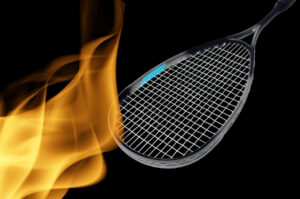Hey there, fellow tennis enthusiasts! It’s Matt, your tennis enthusiast, and today, we’re delving into the fascinating evolution of tennis rackets.
The journey has been remarkable from the early wooden wonders to the sleek, high-tech frames we swing today.
Let’s unravel the secrets behind the metamorphosis of tennis rackets and how these changes have impacted how we play the game.

The Wood Era: Where It All Began
Tennis, as we know it, started with wooden rackets.
The first wooden rackets were heavy, cumbersome, and more akin to a carpenter’s tool than a sports accessory.
As the sport gained popularity, so did the need for innovation in racket design.
Wooden rackets dominated the scene for decades, evolving from solid wood to laminated frames.
A wooden racket’s classic feel and sound remain unmatched, triggering nostalgia for many seasoned players.
However, the limitations in power and control paved the way for the next era.
Enter the Metal Revolution: Aluminum and Steel
The late 20th century witnessed a significant shift with the introduction of metal rackets, specifically aluminum and steel frames.
These lighter, more durable rackets provided players with enhanced power and control.
The transition marked a turning point in tennis technology, setting the stage for further advancements.
Metal rackets gained popularity among amateur and professional players alike.
The unmistakable “ping” sound when the ball hit the strings became synonymous with this era.
However, manufacturers sought ways to push the boundaries as technology progressed.
Graphite Emerges: A Game-Changing Material
In the late 1970s, graphite made its grand entrance into the tennis world.
This lightweight yet robust material revolutionized racket design, offering players a perfect balance of power, control, and maneuverability.
The switch to graphite rackets marked a seismic shift in the game, as professionals and enthusiasts embraced the benefits of this cutting-edge material.
Graphite rackets became the go-to choice for players at all skill levels.
The enhanced performance characteristics allowed for more aggressive playing styles, with players experiencing improved shot-making capabilities.
The game’s feel evolved, as did the expectations for what a tennis racket could deliver.
Midsize, Oversize, and Everything in Between
As tennis continued to evolve, so did racket design. Manufacturers introduced various head sizes, catering to players’ preferences and playing styles.
Midsize rackets offered precision and control, while oversized options provided a larger sweet spot and more power.
The versatility in racket options allowed players to customize their equipment to match their unique playing needs.
The choice between midsize, mid-plus, and oversized rackets became a matter of personal preference.
Each offered a distinct playing experience, influencing the dynamics of the game. With this variety, players could fine-tune their equipment to align with their skill level and desired on-court performance.
Strings: The Unseen Game Changer
While the focus often falls on racket frames, the role of strings in shaping the game cannot be understated.
The transition from traditional gut strings to synthetic materials, such as nylon and polyester, significantly changed how tennis was played.
String technology allowed for more spin, power, and durability, complementing the advancements in racket design.
Players found new ways to generate spin and control the ball with the evolution of string technology.
Hybrid string setups, combining different materials for the main and cross strings, became a popular choice for those seeking a customized feel.
The marriage of advanced racket frames and cutting-edge strings created a synergy that transformed the game’s core.
The Rise of Carbon Fiber: A Lightweight Powerhouse
In the quest for the ultimate tennis racket, manufacturers turned to carbon fiber in the late 20th century.
This ultra-light, yet incredibly strong material allowed for further innovation in racket design.
Carbon fiber rackets offered an unprecedented combination of power, control, and maneuverability, catering to the demands of modern tennis.
The adoption of carbon fiber became a defining moment in racket evolution. Players experienced a significant reduction in weight without compromising performance, enabling quicker swings and enhanced court coverage.
The transition to carbon fiber frames marked a paradigm shift in tennis racket technology, shaping the landscape for years to come.
The Oversize Craze: Changing the Game Dynamics
The late 20th century saw the rise of oversize rackets, with manufacturers pushing the boundaries of head size.
These larger frames promised a more forgiving sweet spot and increased power, enticing players of all levels. The oversize craze left an indelible mark on tennis, influencing playing styles and strategies.
Players wielding oversize rackets could generate impressive power with minimal effort, leading to a shift in the dynamics of the game.
The versatility of these rackets made them popular among recreational players, providing a user-friendly experience on the court.
However, as with any innovation, the oversize trend sparked debates about its impact on the traditional aspects of tennis.
The Technological Revolution: Smart Rackets and Data Analytics
In the 21st century, tennis rackets entered the digital age. Smart rackets equipped with sensors and data analytics capabilities became a reality.
These high-tech marvels allowed players to analyze their performance metrics, including swing speed, ball impact location, and spin rate.
The integration of technology into racket design opened new avenues for players to fine-tune their skills and gain a deeper understanding of their playing style.
Smart rackets became a game-changer for players seeking a data-driven approach to improvement.
The wealth of information provided by these innovative rackets empowered players to make informed decisions about their training and strategy, ushering in a new era of precision and analysis in tennis.
| ERA | RACKET MATERIAL | KEY INNOVATIONS |
|---|---|---|
| Wooden Era | Wood | Heavy, solid wood to laminated frames |
| Metal Revolution | Aluminum and Steel | Lighter, more durable, enhanced power and control |
| Graphite Emerges | Graphite | Lightweight, powerful, improved maneuverability |
| Midsize, Oversize, and Everything in Between | Various | Customizable head sizes for player preferences |
| Strings Evolution | Synthetic Materials | More spin, power, and durability |
| Carbon Fiber Era | Carbon Fiber | Ultra-light, strong, quick swings |
| Oversize Craze | Various | Larger sweet spot, increased power |
| Technological Revolution | Smart Rackets | Sensors, data analytics for performance insights |
Conclusion: Embracing the Future of Tennis Rackets
As we wrap up our journey through the evolution of tennis rackets, one thing is clear – the game has come a long way since the days of wooden frames and gut strings.
From the classic elegance of wood to the high-tech wizardry of carbon fiber and smart technology, each era has left its mark on the sport we love.
Tennis rackets continue to evolve, driven by a relentless pursuit of innovation and performance enhancement.
Whether you’re a seasoned player or a newcomer to the game, the diverse options available today allow you to find a racket that suits your playing style and preferences.
In the ever-changing landscape of tennis technology, one thing remains constant – the joy and excitement of stepping onto the court with a racket that feels like an extension of yourself.
As we eagerly await the next chapter in racket evolution, let’s continue to embrace the magic of tennis and the incredible journey of its iconic companion – the tennis racket.








